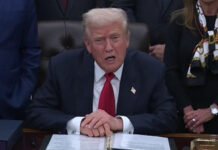– Editorial Articles By Zakir Hussein –
The global trade landscape may be on the verge of a seismic shift as Donald Trump signals a 100% tariff on Russia and its trading partners, should Vladimir Putin refuse to halt military operations in Ukraine within 50 days. While India is not a direct party to the conflict, the ripple effects of such a drastic move could deeply impact India’s trade, energy, defense, and economic diplomacy. As conversations around a US-India trade agreement progress, the potential imposition of secondary tariffs by the United States may add an unexpected and explosive dimension to bilateral negotiations.
Countries Most at Risk from Trump’s Secondary Tariff Plan
If enforced, Trump’s secondary tariff strategy—targeting countries that continue to engage with Russia—will likely disrupt economies closely interlinked with Moscow. Key nations on Washington’s radar include:
India
China
Brazil
Turkey
Vietnam
United Arab Emirates (UAE)
Each of these countries maintains robust trade with Russia, either in energy, defense, agriculture, or financial systems. Should the United States proceed with penalizing these countries, global supply chains, especially in crude oil, fertilizers, weapons systems, and industrial raw materials, could face historic disruptions.
India-Russia Trade Snapshot: A Deep Economic Bond
In FY 2024-25, India and Russia conducted $68.7 billion in bilateral trade. India’s exports stood at $4.88 billion, while imports from Russia surged to $63.84 billion. This asymmetrical trade relationship is dominated by energy and defense imports, two pillars critical to India’s strategic and economic interests.
India’s Exports to Russia Include:
Pharmaceuticals
Iron & Steel
Machinery
Agricultural products
Aircraft parts
Leather goods
Medical and surgical instruments
India’s Imports from Russia Focus on:
Crude oil & petroleum products
Fertilizers
Mineral fuels
Weapons and defense systems
Edible oils
Industrial metals
With over 35% of India’s daily oil needs fulfilled by Russian imports, any disruption—due to tariffs or geopolitical pressure—could force India to recalibrate its entire energy procurement strategy, risking inflation and reduced industrial output.
Impact on India’s Energy Sector: The Crude Reality
Heavy Reliance on Discounted Russian Oil
India imports 1.6 to 1.7 million barrels of oil per day from Russia, a figure that places it among Russia’s largest energy clients. The attractiveness lies in steep discounts, often under $60 per barrel, far below international benchmarks. These rates allow Indian refineries to maximize profit margins, offering competitive fuel prices domestically.
However, under Trump’s secondary tariff policy, Indian oil products derived from Russian crude may face punitive duties in American and European markets. This would:
Undermine India’s refined fuel export profits
Pressure the Rupee due to increased import bills
Spark a supply shock if India pivots to pricier West Asian crude sources
Refinery Compatibility Also at Risk
Russian oil’s high sulphur content is ideal for Indian refinery configurations. Replacing this with low-sulphur American or Gulf crude could necessitate infrastructure overhauls or reduce refinery efficiency—both costly alternatives for Indian energy majors like ONGC, Reliance, and Indian Oil Corporation.
Defense Sector: India’s Strategic Vulnerability
Though India’s reliance on Russian arms has declined—from 72% (2010-14) to 36% (2020-24)—Russia remains a cornerstone of India’s military capability. More than 65% of weapons imported over the last two decades originated from Russia, including:
Sukhoi Su-30 MKI fighter jets
MiG-29 aircraft
MI-17 helicopters
T-90 and T-72 tanks
S-400 missile systems
BrahMos missile systems (jointly developed)
Any US move to penalize ongoing defense deals with Russia could:
Delay critical deliveries
Disrupt maintenance and spare parts supply chains
Stall co-production projects like the AK-203 assault rifle and BrahMos expansion
Additionally, India’s shift toward strategic autonomy in defense through “Make in India” initiatives could suffer setbacks if supply chains from Russia are strained or sanctioned.
Pharmaceutical and Fertilizer Trade Under Threat
India’s pharmaceutical exports to Russia—valued in hundreds of millions—may also suffer. With the US being India’s largest pharma market, secondary sanctions could result in:
Loss of credibility
Tariff impositions on Indian generics
Stricter FDA scrutiny, possibly motivated by geopolitics
Moreover, Russian fertilizers, vital to India’s agriculture, may become inaccessible or expensive, triggering:
Higher input costs for farmers
Potential food inflation
Increased subsidy burden on the Indian government
Financial, Currency, and Shipping Disruptions
India and Russia recently deepened their financial ties via the rupee-ruble and rupee-dirham trade settlements. If Trump’s measures extend to financial institutions or SWIFT alternatives being used to bypass US sanctions, India may face:
Delayed payments and settlements
Reduced access to critical commodities
Higher risk premiums on international transactions
UAE, Brazil, Turkey: Global Partners in the Crosshairs
India isn’t alone. Other Russian trading partners also stand to lose significantly:
UAE
Acts as a financial hub for Russian forex transactions
Hosts Russian oligarch assets
May face currency devaluation pressures if Dirham is sanctioned
Turkey
Despite NATO ties, continues purchasing natural gas and S-400 missiles from Russia
Trump’s tariffs could deepen Ankara’s economic crisis and jeopardize ties with Washington
Brazil
Imports large quantities of cheap Russian fertilizer
Agriculture sector, especially soybean and sugarcane, could take a major hit
Secondary sanctions could throttle Brazil’s agricultural exports to the US and EU
Conclusion: India’s Tightrope Walk Between Washington and Moscow
India’s foreign policy has long thrived on strategic non-alignment, engaging both the US and Russia without antagonizing either. But Trump’s proposed 100% tariff on Russia and its trading partners forces New Delhi into a high-stakes diplomatic conundrum.
Should India continue trade with Russia, it risks:
Retaliatory tariffs
Diplomatic frictions
Supply chain disruptions
But disengaging from Russia would mean:
Higher energy costs
Defense capability setbacks
Agricultural dependency issues
As the US-India trade agreement nears finalization, this evolving tariff threat could either become a bargaining chip or a deal-breaker. For now, India must walk the tightrope—balancing economic pragmatism with geopolitical foresight—to safeguard its national interests in an increasingly polarized global order.
















